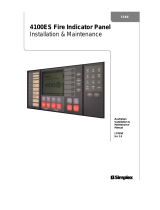Baldwin Boxall BVRDNET is a networking system for BVRD2M & BVRD2M4 systems that enables up to 126 systems to be connected in a loop configuration. The network can be either Copper, Multi Mode Fibre, Single Mode Fibre or a combination of both using the BVRDCIF, BVRDFIF and BVRDFIFS interface modules.
It enables the distribution of two RS485 communication ports and up to 14 concurrent audio channels around the network. The maximum distances for copper connection are 300m for “slow speed” providing six concurrent audio channels and 200m for “fast speed” providing 14 concurrent audio channels. The maximum distance for a multi-mode fibre connection is 3km and 4km for a single mode fibre connection.
Baldwin Boxall BVRDNET is a networking system for BVRD2M & BVRD2M4 systems that enables up to 126 systems to be connected in a loop configuration. The network can be either Copper, Multi Mode Fibre, Single Mode Fibre or a combination of both using the BVRDCIF, BVRDFIF and BVRDFIFS interface modules.
It enables the distribution of two RS485 communication ports and up to 14 concurrent audio channels around the network. The maximum distances for copper connection are 300m for “slow speed” providing six concurrent audio channels and 200m for “fast speed” providing 14 concurrent audio channels. The maximum distance for a multi-mode fibre connection is 3km and 4km for a single mode fibre connection.


















-
 1
1
-
 2
2
-
 3
3
-
 4
4
-
 5
5
-
 6
6
-
 7
7
-
 8
8
-
 9
9
-
 10
10
-
 11
11
-
 12
12
-
 13
13
-
 14
14
-
 15
15
-
 16
16
-
 17
17
-
 18
18
Baldwin Boxall BVRDNET Installation guide
- Type
- Installation guide
- This manual is also suitable for
Baldwin Boxall BVRDNET is a networking system for BVRD2M & BVRD2M4 systems that enables up to 126 systems to be connected in a loop configuration. The network can be either Copper, Multi Mode Fibre, Single Mode Fibre or a combination of both using the BVRDCIF, BVRDFIF and BVRDFIFS interface modules.
It enables the distribution of two RS485 communication ports and up to 14 concurrent audio channels around the network. The maximum distances for copper connection are 300m for “slow speed” providing six concurrent audio channels and 200m for “fast speed” providing 14 concurrent audio channels. The maximum distance for a multi-mode fibre connection is 3km and 4km for a single mode fibre connection.
Ask a question and I''ll find the answer in the document
Finding information in a document is now easier with AI
Related papers
-
Baldwin Boxall BVRAMB Installation guide
-
Baldwin Boxall BVRAMBIP Installation guide
-
Baldwin Boxall BDM400 User manual
-
Baldwin Boxall BVCR Installation guide
-
Baldwin Boxall BV125D Installation guide
-
Baldwin Boxall BVCR User manual
-
Baldwin Boxall BVMX Operating instructions
-
Baldwin Boxall M2000I Operating instructions
-
Baldwin Boxall VIGIL Eclipse4 Installation Details
-
Baldwin Boxall BVRD485R Installation guide
Other documents
-
VERITAS Flex 5340 Appliance Product Description
-
ADDER AdderLink Infinity Manager User manual
-
 Simplex MINIPLEX 4100ES Series Installation & Maintenance
Simplex MINIPLEX 4100ES Series Installation & Maintenance
-
ADDER AdderLink Infinity 2112T User manual
-
Dell QLogic Family of Adapters User guide
-
Motorola Canopy 150 Mbps Backhaul User manual
-
VERITAS NetBackup 5230 Appliance Product Description
-
Dell QLogic Family of Adapters User guide
-
Tyco 0-1591500-x Product User Manual
-
Sun Microsystems StorageTek 2500 Series User manual


















